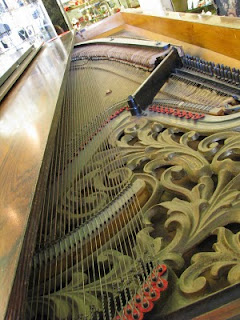After further discussion and a fair bit of web research, we decided that it would be a nice 20th anniversary present to ourselves to buy the piano and have it restored, and make it a special feature of our remodeled house.
(If only we can get the remodel to happen.)
Our web research turned up the Antique Piano Shop web site, which is clearly the most useful and popular web site on the subject. The owner, Michael Stinnett, has been restoring pianos since he was a teenager, and we think is almost single-handedly responsible for there being any market for restoring them at all. From some modern musicians' perspectives, they are not desirable. However, our interest isn't primarily in having a professional instrument worthy of a grand concert hall--we're more excited about preserving a bit of Americana. There's also the issue of authenticity: the modern piano sounds considerably different from what composers of the 1800s played on and wrote for.
We went back to the store and spent a little time playing the piano to see how functional it was. It turned out to be surprisingly functional. Some of the low notes had problems with damping, and the high end was out of tune, but in the middle, it worked well (notwithstanding that all the felts desperately need replaced). We figure that is promising for restoration potential.
We wrote to Michael Stinnett to see if he could tell us how old the piano was, and how much it might make sense to pay for it. By looking up the serial number, he was able to tell us
AGE: According to the serial number you provided, your piano was built in 1853. We estimate that less than 10% of the surviving square pianos today are from the pre-Civil War era. These pianos are exceedingly rare.1853 is the year that Stephen Foster wrote "Old Kentucky Home". More:
Let me start by saying that A. H. Gale built exceptional pianos. Although they are very rare, we have restored a handful of A. H. Gale square grand pianos over the years. They are consistently some of the most well made square pianos we see come through our shop. We have seen some vintage catalogs showing square pianos selling for as much as several hundred dollars at the turn of the century...the cost of a small house of the era! In the past decade alone we have seen these pianos nearly DOUBLE in value, making their restoration a very good investment. You most likely have a wonderful piano there with a lot of potential.Also:
The models with the Mother Of Pearl as you described were used only on the most expensive, high-grade pianos offered at the time.Well, that's encouraging, even keeping in mind that his interest is in convincing us to restore it. It doesn't matter to us whether we could potentially sell it for more than we put into it. We intend to keep it. We really wanted to know was that we weren't getting, say, the least-worth-preserving piano out there. At any given time, there are plenty of unrestored square grands available on eBay.
So we put it on layaway. Not because we are strapped for cash, but because that gets them to store it for us for a while. We want to ship it direct from the store to the restoration shop, and from there to our remodeled house. To do that, we need to get the remodel done!
The piano has an interesting history. More on that next time.
The piano has an interesting history. More on that next time.





No comments:
Post a Comment